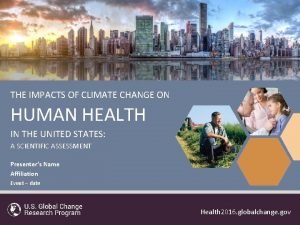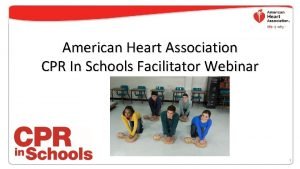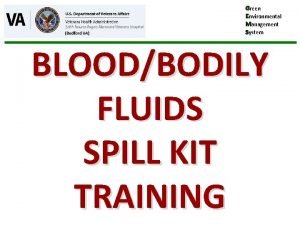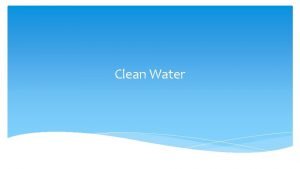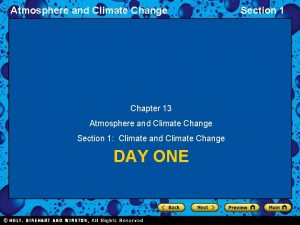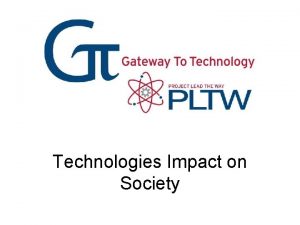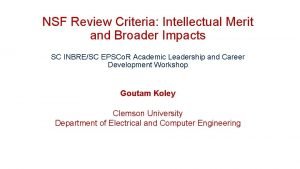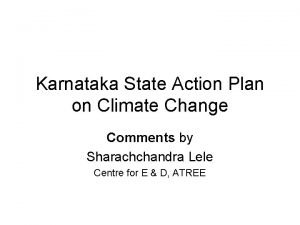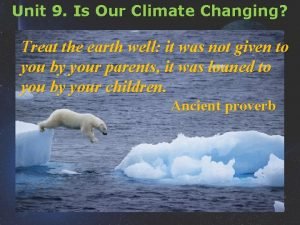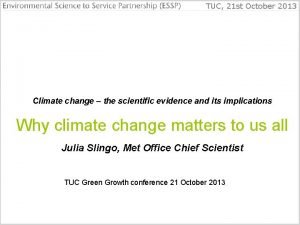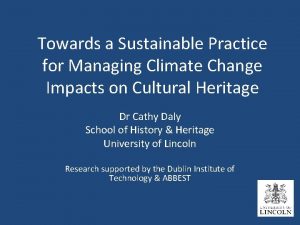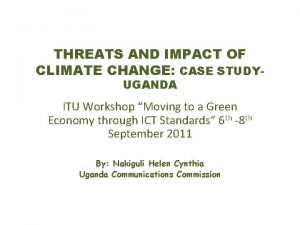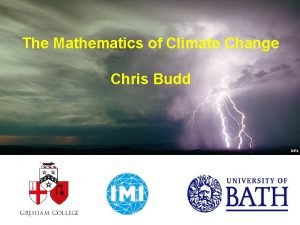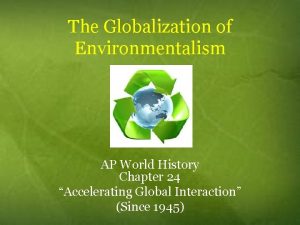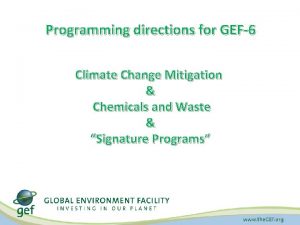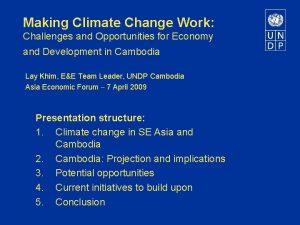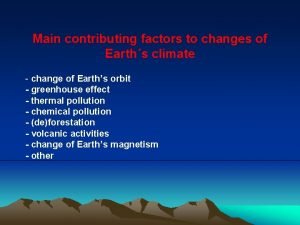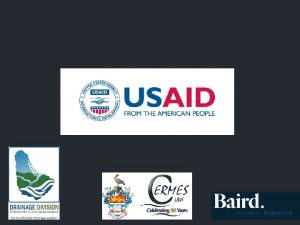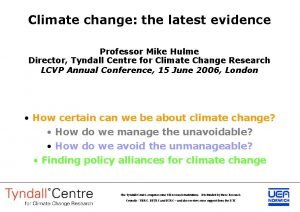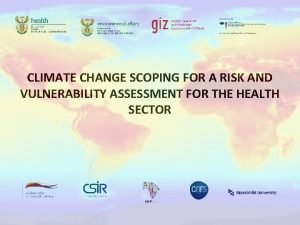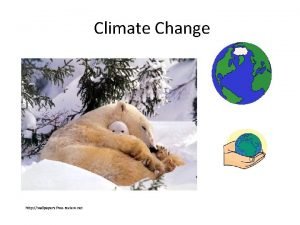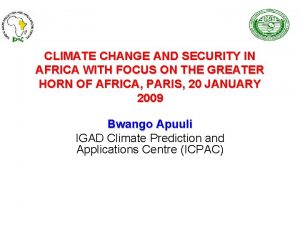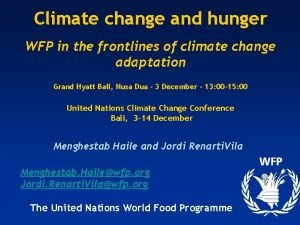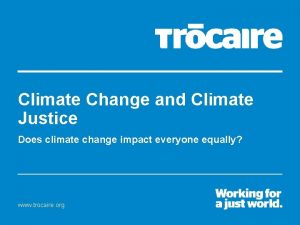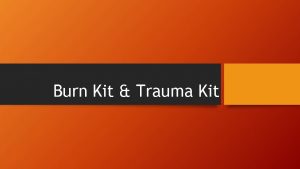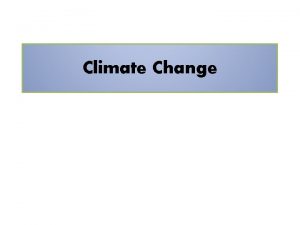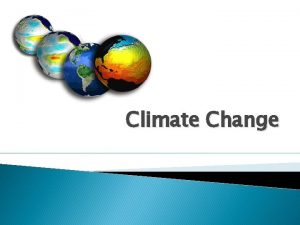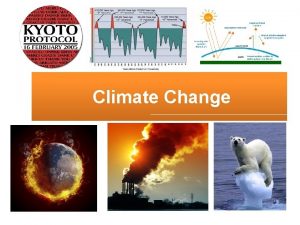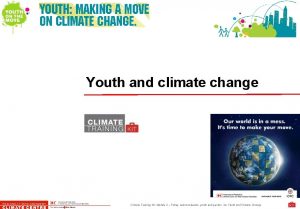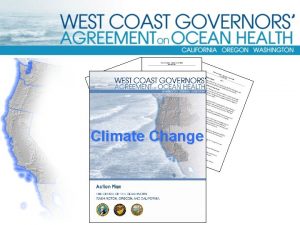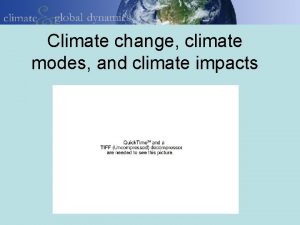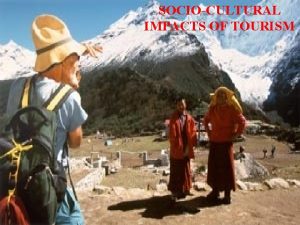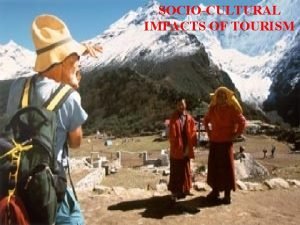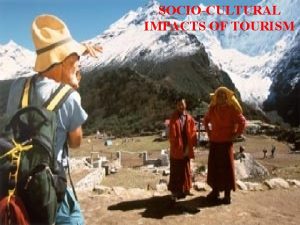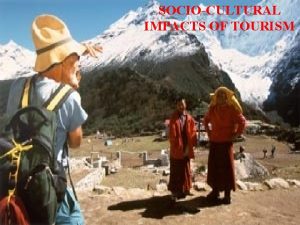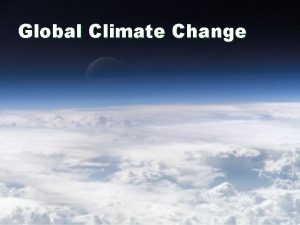Climate Change Science and Impacts Climate Training Kit



































- Slides: 35

Climate Change: Science and Impacts Climate Training Kit. Module 1 a – Climate change science and impacts

In this module: Why is the climate changing? What are the impacts of climate change? What does this mean for humanitarians? Photo: NASA Climate Training Kit. Module 1 a – Climate change science and impacts

Climate Change Climate Training Kit. Module 1 a – Climate change science and impacts

People report changes – and needs ”More and worse floods” ”Rains no longer normal – difficult to know when to plant” ”Our fields get eaten away by the sea” ”. . . so our children have to move away” Climate Training Kit. Module 1 a – Climate change science and impacts

… and scientists’ data and observations confirm that the problems are global 1978 2002 Source: T. P. Barnett, J. C. Adam and D. P. Lettenmaier: Nature 438, 303 -309 (17 November 2005) Climate Training Kit. Module 1 a – Climate change science and impacts

Weather or climate? Weather: Short Timescales “hours, days” Will I need an umbrella today? Is it raining? What is the weather? Climate: Long Timescales “average over the past 30 years” I’m going to Nairobi in May – is that normally the rainy season there? What is the climate? Climate Training Kit. Module 1 a – Climate change science and impacts

IPCC – the ‘key reference’ on climate change Main findings IPCC Fifth Assessment Report, 2013 Climate change is already happening It is mostly caused by man It will continue The rate of change is alarming Extreme weather is getting more frequent It is urgent to stop further warming Climate Training Kit. Module 1 a – Climate change science and impacts

First question: Why is it getting warmer? Answer: The rapid global warming of the past 100 years is caused mostly by human activity, mainly: Burning fossil fuels (e. g. coal, oil, natural gas) at unprecedented rates, sending “greenhouse gases” into the atmosphere Widespread deforestation (trees contain a lot of carbon, and when burnt CO 2 is released ) Changing agricultural and land-use practices (agriculture releases other GHGs, CH 4 and NO 2) Climate Training Kit. Module 1 a – Climate change science and impacts

First question: Why is it getting warmer? Greenhouse gases are acting as a blanket around the earth Climate Training Kit. Module 1 a – Climate change science and impacts

Second Question: Along with the GHG the earth is getting warmer – what does that mean? Rising temperatures, heat waves Sea level rise Scientists very sure Melting ice Ocean acidification Changing rainfall patterns Changes in extreme events Less clear, and regional differences Climate Training Kit. Module 1 a – Climate change science and impacts

It’s getting hotter… Global temperatures are already rising Climate Training Kit. Module 1 a – Climate change science and impacts

Warming will continue, but how much is our choice In the next few decades, temperatures will continue to rise, even if we almost completely stop emissions of GHGs today (blue line) This is because GHGs, especially CO 2, stay in the atmosphere for a long time Therefore, we have further climate change “in the pipeline” because of the emissions already in the atmosphere Climate Training Kit. Module 1 a – Climate change science and impacts

Warming will continue, but how much is our choice But if, and only if, we cut the global amount of GHG emissions quickly, we may avoid escalating warming in the second half of this century (the red line) If we act now to reduce global emissions, it is still possible to keep changes within a “manageable range” for our children Climate Training Kit. Module 1 a – Climate change science and impacts

Scientist warnings are clear: We should avoid more than a 2°Celsius temperature rise in the coming century A 2012 World Bank report summarizes the potential effects of a 4°warmer world: it’s urgent to limit GHG emissions The more we limit GHG emissions now, the less need for adaption to a future wilder weather Climate Training Kit. Module 1 a – Climate change science and impacts

Rainfall is changing… Expected change in rainfall compared to NOW (1986 -2005) Low scenario – if humans cause less climate change High scenario – if humans cause more climate change …but high uncertainties in many regions Climate Training Kit. Module 1 a – Climate change science and impacts

Sri Lankan example: rainfall change New record highs Long term average Climate Training Kit. Module 1 a – Climate change science and impacts

Third Question: What does climate change mean for the humanitarian sector? Trends we have observed: Weather related disasters doubled over the past 2 decades Increase in small- and medium-scale disasters Climate Training Kit. Module 1 a – Climate change science and impacts

Risks = Hazards x Vulnerability x Exposure The number of hazards is increasing More people are exposed to extreme events The vulnerability of people and assets is increasing = Risks are increasing Climate Training Kit. Module 1 a – Climate change science and impacts

Projected changes in disaster patterns “A changing climate leads to changes in the frequency, intensity, spatial extent, duration, and timing of extreme weather and climate events, and can result in unprecedented extreme weather and climate events. ” (IPCC, SREX, 2012) Climate Training Kit. Module 1 a – Climate change science and impacts

Potential impact: Rising temperatures (source: NOAA-NCDC ) Heat waves: Rising temperatures lead not only to changes of average temperature but also to weather extremes. The increase of extreme weather-related disasters is particularly important for the Red Cross Red Crescent Climate Training Kit. Module 1 a – Climate change science and impacts

Potential impact: Changing rainfall patterns Rainfall seasons around the world might shift major implications for global agriculture Amount of rainfall in each region might change Number of extremely rainy events might increase in many places changes in floods and water flows Other places could see an increased number/duration of dry spells water stress for vulnerable populations Rainfall on very wet days NOW Climate Training Kit. Module 1 a – Climate change science and impacts

Shift in seasonality as important as amount Climate Training Kit. Module 1 a – Climate change science and impacts

Potential impact: Floods Difficult to measure the frequency and intensity of floods, but generally there has been an increasing trend Changes in rainfall patterns and precipitation intensity could put more people at risk from flooding Photo: IFRC, Pakistan floods 2010, Climate Training Kit. Module 1 a – Climate change science and impacts

Potential impact: Coastal erosion, coastal flooding and salt water intrusion Photo: IFRC, Viet Nam coastal dike damages Climate Training Kit. Module 1 a – Climate change science and impacts

Potential impact: Drought Photo: Jacob Dall Climate Training Kit. Module 1 a – Climate change science and impacts

Possible impact: increasing food insecurity (Photo: Tamara Leigh/IFRC-Climate Centre) Climate Training Kit. Module 1 a – Climate change science and impacts

Possible impact: Changing disease patterns (Photo: Nancy Okwengu/IFRC-Climate Centre) Climate Training Kit. Module 1 a – Climate change science and impacts

Potential impact: Melting ice 1978 2002 Source: NASA – UNDP Source: Barnett et al. (2005) Climate Training Kit. Module 1 a – Climate change science and impacts

Potential impacts: Oceanic changes Sea levels are rising – at a faster rate Sea level rise NOW Climate Training Kit. Module 1 a – Climate change science and impacts

Potential impacts: Oceanic changes Large scale degradation and/or loss of coastal and marine ecosystems the oceans are becoming more acidic sea surface temperatures are increasing . . . and fish stocks decline, eroding livelihoods for millions of people Ocean acidification damages coral reefs – reducing their coastal protection effects Climate Training Kit. Module 1 a – Climate change science and impacts

Potential impact: tropical cyclones impacts Possibly an increase in the intensity of tropical cyclone activity (hurricanes/typhoons), coupled with higher storm surges due to sea level rise economic/human losses are expected to increase IFRC Source: NOAA Climate Training Kit. Module 1 a – Climate change science and impacts

RC action: Improve climate risk management In summary (more details in other CTK modules): • Climate risk assessments – check how our programming should be adjusted to meet new risk patterns • More and better disaster preparedness at all levels: Early warning – Early action plans with pre-determined actions triggered by information at different time scales • Up-scaling of climate-smart community risk reduction activities • More flexible, climate-smart health programming • Partnerships with weather agencies and technical specialists on adaptation options • Influence climate change policies Climate Training Kit. Module 1 a – Climate change science and impacts

Geo-engineering: an emerging risk! UNEP 2009 – adapted from Lenton & Vaughan 2009 Climate Training Kit. Module 1 a – Climate change science and impacts

Humanitarian concern • Will vulnerable people worldwide have a voice in geoengineering decisions? • Will there be extra funding for humanitarian work in a geoengineered future? Climate Training Kit. Module 1 a – Climate change science and impacts

THANK YOU! Further information: ipcc. ch climatecentre. org ifrc. org Climate Training Kit. Module 1 a – Climate change science and impacts
 Climate change 2014 mitigation of climate change
Climate change 2014 mitigation of climate change Impacts of climate change
Impacts of climate change Talk about your favorite subject at school
Talk about your favorite subject at school American heart association cpr in schools
American heart association cpr in schools Exam 70-464 training kit
Exam 70-464 training kit Spill kit training presentation
Spill kit training presentation Science olympiad wright stuff kit
Science olympiad wright stuff kit Clean water science kit
Clean water science kit Climate change meaning
Climate change meaning Chapter 13 atmosphere and climate change section 1
Chapter 13 atmosphere and climate change section 1 Chapter 13 atmosphere and climate change
Chapter 13 atmosphere and climate change What is technology
What is technology Positive and negative impacts of materials technology
Positive and negative impacts of materials technology Impacts of medical technology
Impacts of medical technology Intellectual merit and broader impacts
Intellectual merit and broader impacts Climate change paragraph
Climate change paragraph Karnataka state action plan on climate change
Karnataka state action plan on climate change Climate types brainpop
Climate types brainpop Unit 9 climate change
Unit 9 climate change Conclusion of climate change
Conclusion of climate change Conclusion of climate change
Conclusion of climate change Conclusion of climate change
Conclusion of climate change Mathematics of climate change
Mathematics of climate change Globalization ap world history definition
Globalization ap world history definition Climate change mitigation
Climate change mitigation Pc 414
Pc 414 Conclusion of climate change
Conclusion of climate change Factors of climate change
Factors of climate change Conclusion of climate change
Conclusion of climate change Theoretical framework example
Theoretical framework example Uk climate change
Uk climate change Climate change interview
Climate change interview Factors that affect climate change
Factors that affect climate change Conclusion of climate change
Conclusion of climate change Conclusion of climate change
Conclusion of climate change Climate change causing droughts
Climate change causing droughts

